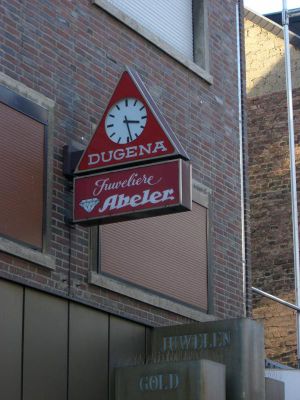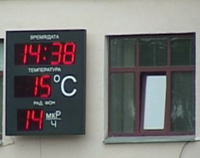Talk:Tag:amenity=clock
Faces
What about faces=*, for example some clocks on pillars or poles have three or (like Example 1, overleaf) four faces. Andy Mabbett (User:Pigsonthewing); Andy's talk; Andy's edits 23:05, 21 November 2011 (UTC)
- I've added this as faces=N. Andy Mabbett (User:Pigsonthewing); Andy's talk; Andy's edits 20:11, 30 January 2012 (UTC)
Floral clocks
What about floral clocks? display=floral?Andy Mabbett (User:Pigsonthewing); Andy's talk; Andy's edits 20:06, 30 January 2012 (UTC)
- The flowers are the material of which the clock is made, not the display type of the clock. So, it would still be display=analogue, but you could add material=floral. --Pbb (talk) 07:57, 31 August 2015 (UTC)
What about disused clocks?
amenity=clock seems like a useful thing to have, but there's one problem I can see: what about disused clocks? Is this useful information to even bother collecting (hey, if disused train stations, which aren't publicly accessible is in OSM, I don't see why disused clocks, which are publicly viewable shouldn't be). If we're gonna tag them, is there a way to do so?
A few I can think of:
- On top of Tunbridge Wells railway station, there is a stopped clock
- On the side of a building in the Strand in London, there is a large stopped analogue clock.
One potential use for collecting this information is actually to enable people to lobby local authorities and others responsible for maintaining public clocks to fix the clocks and get them going again. Tom Morris 09:53, 7 June 2012 (BST)
- I guess disused=* and/or abandoned=* could be used for this purpose. AlfonZ 10:29, 7 June 2012 (BST)
- [ec]Hey, at least they're right twice a day! Seriously, good point. Also worth remembering that clocks are still landmarks, even if stopped. There was a website which listed them, stoppedclocks.com, but without coordinates. Also, It seems to have gone AWOL. (Archive.net has a snapshot) - two good reasons why such things are best mapped in OSM. Andy Mabbett (User:Pigsonthewing); Andy's talk; Andy's edits 11:17, 7 June 2012 (BST)
- Update The Stopped clocks site is still live, at http://moblog.net/stopped/ (and should be back at the former address, once a bug is fixed). Andy Mabbett (User:Pigsonthewing); Andy's talk; Andy's edits 12:09, 7 June 2012 (BST)
- Update Alfie here from the stopped clocks project. The moblog where all the clocks are posted (over 300 in the UK so far) are in the main also located using Google Streetmap, with the lat/long accessible on the map page here: view-source:http://moblog.net/map/blog/stopped/ - hope this is helpful!
- disused:amenity=clock seems like the correct tagging for a clock that stopped working. For a clock that was destroyed (vandalized?), abandoned:amenity=clock would be right. --Pbb (talk) 08:21, 31 August 2015 (UTC)
Who says it is a stopped clock is disused when all the observer can tell is that it is stopped. Jidanni (talk) 11:43, 21 June 2023 (UTC)
Display value in American English
The suggested display=* value analog is American English. In British English, which we use for our tags, this should be analogue.-- Dieterdreist (talk) 11:52, 17 September 2014 (UTC)
- I don't think it's worth changing this. --Andrew Shadura (talk) 13:02, 17 September 2014 (UTC)
- Yes, it should be analogue and this is how I tag it --Paul The Archivist (talk) 23:30, 20 March 2015 (UTC)
- +1 for analogue. Can somebody generate comparative stats for the two spellings, please? Andy Mabbett (User:Pigsonthewing); Andy's talk; Andy's edits 15:05, 21 March 2015 (UTC)
- Comparative stats --Tordanik 01:47, 22 March 2015 (UTC)
- +1 for me too. The usage stats are not a guideline, because everybody who has no bias will just copy the value from the wiki. Consistency is important, and OSM follows UK English conventions, not US. (See also Highways, Sidewalks and Key:level.)--Pbb (talk) 08:07, 31 August 2015 (UTC)
lit=*
Currently I am using lit=* for clocks which are lit during the nighttime.
- Yeah, well, sounds good to me. I think it makes sense to use lit=* instead of e. g. luminous=* for lit dials, even when the light comes from the inner of the clock itself, because the clock does not emit light to illuminate another feature, but to illuminate the dial. --Elefant aus Wuppertal (talk) 16:49, 4 May 2023 (UTC)
Wall mounted: two types
If support=wall_mounted is used for clocks whose faces are perpendicular to wall, like that in the first image shown above, what should we use for clocks whose faces are flush/ parallel to the wall, like that in the second image? Andy Mabbett (User:Pigsonthewing); Andy's talk; Andy's edits 15:03, 21 March 2015 (UTC)
How to express that the clock shows the level of radiation?
--AquaGen (talk) 03:47, 5 July 2015 (UTC)
Clock Towers
What about clock towers? My initial supposition was to tag both building=yes and amenity=clock but it's not supposed to be used on an area. Technically the clock is wall-mounted but also technically there's four clocks. Except that in the case of, for example, Big Ben, the same internal mechanism drives them all. It's both a building and a clock.
- @Herrshuster: That's only how it is proposed. I don't see a reason why it couldn't be used on areas. You can use https://taginfo.openstreetmap.org/compare/man_made=tower/tower:type=clock. However, there's not "four clocks", but 4 clock faces. Use faces=*. -- Kovposch (talk) 09:42, 25 February 2020 (UTC)
Giant sundials
Some clocks might be many meters wide sundials. So consider allowing areas as well as points. Jidanni (talk) 00:08, 30 April 2020 (UTC)
- I follow this, https://www.openstreetmap.org/way/295700670 is another example. --Martinligabue (talk) 14:50, 9 April 2024 (UTC)
How to express whether a clock has a second hand?
How to indicate that (/if) a clock has a second hand? Since the key second_hand=* is already assigned and has a different meaning, I would suggest the key seconds=*. --Elefant aus Wuppertal (talk) 16:49, 4 May 2023 (UTC)
Sounds
How to indicate if the clock bells/chimes the time? It may have an operating interval (like only during daytime) and a frequency (hourly or quarter hourly).
And how to indicate if the clock plays music? (Again, interval and frequency.)
Any tags for clock towers with animated puppets? ITineris (talk) 14:48, 15 August 2024 (UTC)
- Proposal:Bell : Adding bell=* to the amenity=clock should be the best at first. amenity=bell would conflict with amenity=clock when at the same point, as not all are as big as a tower:type=clock area. (But this is for mechanical bells. For electric ringtones, need to invent eg clock:sound=* as in traffic_signals:sound=* )
- There's 7
 bell:service_times=* . This was mentioned in Proposal:Bell#Attributes for service_times=* . Perhaps a bell:opening_hours=* may be mistaken for whether big ones are open for visit.
bell:service_times=* . This was mentioned in Proposal:Bell#Attributes for service_times=* . Perhaps a bell:opening_hours=* may be mistaken for whether big ones are open for visit. - It should be interval=* , so bell:interval=* ? frequency=* refers to waveforms, where the 1
 bell:frequency=* is actually bell:frequency=534 for 534Hz sound apparently. Alongside, 4
bell:frequency=* is actually bell:frequency=534 for 534Hz sound apparently. Alongside, 4  bell:tone=* in music notation.
bell:tone=* in music notation.
- There's 7
- A clock:sound=* as envisioned above would be needed. Musical chimes can actually be played for alerting purposes at train platforms (in Japan), so *:sound=* should still be fine. Not sure about music=* , which might be for a full song, or at least a verse, not a short excerpt in clocks. Or how long do your clocks play the music?
- Good question. No idea. Apparently termed
 Automaton#Clocks , same in orchestrions. Nothing for cuckoos either. Wonder whether there's overlap with tourism=artwork ? animated=* in advertising=* isn't good, as clocks already show changing time, and there's overlap with display=* .
Automaton#Clocks , same in orchestrions. Nothing for cuckoos either. Wonder whether there's overlap with tourism=artwork ? animated=* in advertising=* isn't good, as clocks already show changing time, and there's overlap with display=* .
- Proposal:Bell : Adding bell=* to the amenity=clock should be the best at first. amenity=bell would conflict with amenity=clock when at the same point, as not all are as big as a tower:type=clock area. (But this is for mechanical bells. For electric ringtones, need to invent eg clock:sound=* as in traffic_signals:sound=* )
—— Kovposch (talk) 11:32, 16 August 2024 (UTC)


